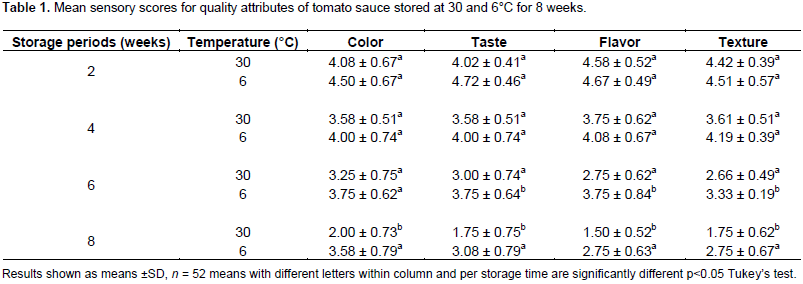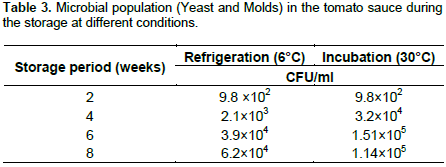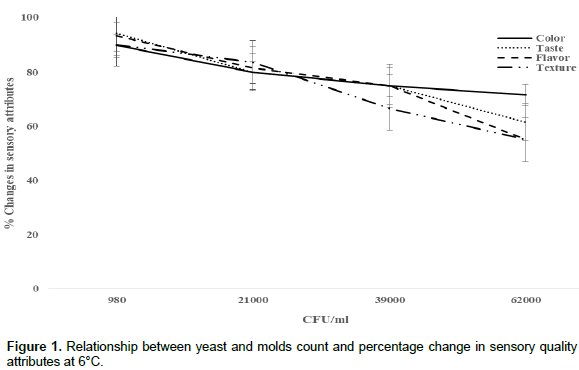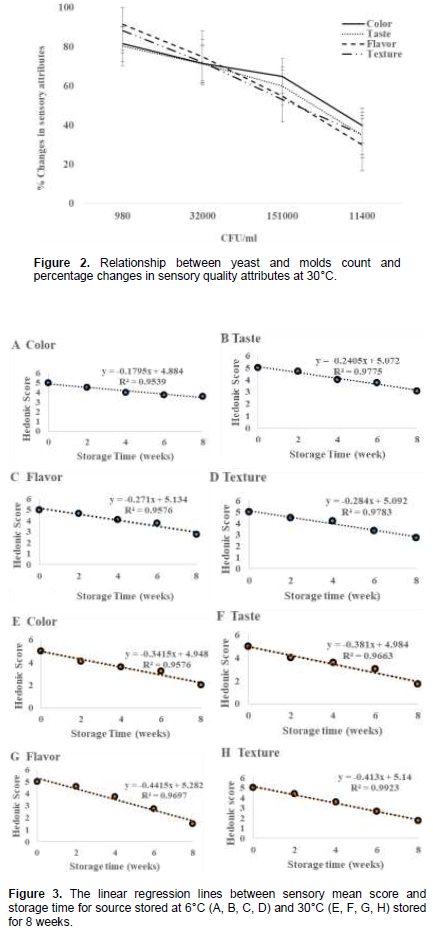ABSTRACT
Tomato (Lycopersicon esculentum) is processed into different products including tomato sauce. The aim of this study was to determine the quality attributes of homemade tomato sauce during storage at 6 and 30°C for 8 weeks. At 4 weeks, there were no significant changes in sensory attributes during storage at both 6 and 30°C. There were significant differences (PË‚0.05) of sensory attributes after 6 weeks. Sauce stored at 30°C had higher microbial load than at 6°C. Both sensory mean scores and pH were inversely related to microbial growth. Therefore, the shelf-life of homemade tomato sauce could be increased at low temperature (6°C).
Key words: Homemade tomato sauce, storage temperatures, sensory, attributes.
Tomato (Lycopersicon esculentum Mill.) is one of the most important agricultural products among fresh vegetables in most countries in the world. It is widely distributed in Asia, Europe, North and South America, and North Africa. Tomato belongs to the Solanaceae family. Tomatoes are consumed widely throughout the world in different forms such as canned whole tomatoes, tomato juice, tomato sauce, tomato paste and ketchup sauce (Wasim and Singh, 2015; Anthon and Barrett, 2010; Hossain et al., 2011). Among crops, tomato (L. esculentum), with a total production of around 160 million tons per year, is the second most important source of nourishment (after potatoes) for the world’s population (FAOSTAT, 2015). Its consumption has increased in the last few years with the commercialization of several processed products such as sauces, juices, soups and purees. It has been estimated that 35% of raw tomatoes are consumed as sauces, 18% as tomato paste, 17% as canned tomatoes, 15% are transformed into juices and 15% into ketchup (Canene-Adams et al., 2005; Raiola et al., 2014). Tomato consumption has recently been demonstrated to possess health benefits (Levy and Sharoni, 2004; Hsu et al., 2008; Eunmi et al., 2012), because of its rich content of bioactive phytonutrients such as lycopene, β-carotene, vitamins E and C, phenolics, organic acids and flavonoids (Kaur et al., 2002; Periago and Garcia-Alonso, 2009; Kalogeropoulos et al., 2012; Trivedi and Patel, 2015). Consumption of tomatoes and tomato sauce was associated with a reduced risk of developing digestive tract and prostate cancers (Campbell et al., 2004). Tomatoes are also one of the main parts of the Mediterranean diet which has been associated with a low mortality from cardiovascular troubles. Because tomatoes constitute the almost exclusive source of lycopene, this pigment could be one of the active agents of this protection (Helyes et al., 2009; Shi et al., 2009).
Tomato is a relatively short duration crop and gives a high yield, it is economically attractive and the area under cultivation is increasing daily, but prone to spoilage due to high water content (AVRDC, 1992). To provide diverse tomato products, drying and making of tomato pulp remain the most commonly used processing and preservation method practised by smallholder farmers (AVRDC, 1992). Solar drying in particular is a widely practised form of preserving fruits and vegetables because it is cheap and no energy cost is incurred (Ayua et al., 2017). However, dried products may require reconstitution, which may be inconvenient to consumers. As an alternative solution to drying, refrigeration and holding tomatoes at room temperatures either in their fresh forms or as processed tomato sauces are widely done (Raci et al., 2014). Tomato sauce is made from tomato concentrate containing 8 to 24% tomato solids (excluding seeds and peels), and usually containing flavorings such as salt, onion or garlic powder, herbs and flavorings (Featherstone, 2015). To have economic impacts, tomato sauce must retain quality attributes. However, quality changes have been reported during storage of tomato products (Wasim and Singh, 2015). Some of the factors that have been reported to influence the quality of tomato sauce include storage temperature and preservatives added during tomato processing (Khan et al 2011; Hossain et al., 2011). Some studies have reported that tomato products stored at ambient temperatures are prone to rapid spoilage than those refrigerated or frozen (Safdar et al., 2010; Hossain et al., 2011; Wasim and Singh, 2015; Lavelli and Torresani, 2011).
These studies observed increased rate of enzymatic reactions, increased microbial growth or activities and decreased consumer acceptance in tomato products stored at ambient temperature. Another significant factor that influences the quality of tomato sauce is lycopene (Martinez-Hernandez et al., 2016). Lycopene, a pigment responsible for the red colour of tomatoes and their products can be degraded by processing conditions such as lengthened durations of heating, high temperatures and exposure to oxygen (Shi et al., 1999). These authors reported that lycopene can be isomerised to its cis form during processing and storage subsequently leading to significant losses in the color of tomato sauce. Oxidation of ascorbic acid, enzymatic and Maillard reactions have also been reported to influence color loss in tomato products and these impacted the overall acceptability of tomato products (Wasim and Singh, 2015; Charles et al., 2005). However, results are inconsistent, as some authors have reported an increase in extraction efficiency in lycopene when tomatoes were processed then stored (Re et al., 2009). These discrepancies could be attributed to differences in genetic composition, temperature of storage, and the different heat treatments applied during tomato products processing. As such, unanimous conclusions on the effect of various storage conditions on quality of tomato sauce have not been concluded. Therefore, this study aimed to evaluate quality attributes of homemade-tomato sauce stored at 6 and 30°C.
Preparation of homemade tomato sauce
The tomato sauce was prepared as described by Khan et al. (2011) with modifications. One kilogram of sorted ripe tomatoes bought from Lilongwe market, Malawi, was washed then blanched at 80°C for 15 to 20 min after which they were cooled using cold water, peeled and the resultant product was strained through a sieve to remove the seeds. A table spoon each of oil, ginger, cloves garlic, thyme leaves and corn starch were added to the resultant paste and mixed well in a blender. The mixture was then heated for 4 to 5 min at 100°C and then sugar and salt were each added. The mixture was further left to boil at the same temperature for 25 to 30 min with stirring. The product (sauce) obtained was further cooked at a lower temperature until a desirable thickness was obtained. Finally, corn starch was added to enhance thickening.
Tomato sauce packaging and storage
The prepared tomato sauce was packaged in 500 ml-bottles. Prior to packaging, the bottles were pasteurized at 100°C for 15 min. Sodium benzoate (0.01%) was added to the sauce (Heinz, 2013). Finally, the bottles were cooled and stored at two different temperatures, 6 and 30°C.
Sensory evaluation
The widely used 5-point hedonic scale for evaluating sensory characteristics such as color, taste, flavor and texture was used (De Groote et al., 2014). Panelists were asked to evaluate tomato sauce at each testing time session on the 5 point scale (5 = Like extremely; 4 = Like very much; 3 = Like moderately; 2 = Neither like nor dislike; 1 = Dislike). In order to determine how much stored tomato sauce (stored at 6 and 30°C) deviated from fresh sauce (control) in terms of sensory attributes, a fresh tomato sauce was made during each sensory evaluation session. Separately, same panelists were asked to give point difference between fresh sauce and stored sauce (6 and 30°C) on 0-5 scale (0 = no difference to 5 = very different). The differences between the stored sauce and the fresh sauce were used in determining the paired mean differences. Water was also availed to each panelist to clean their palates before testing the next sample.
Study participants
Panelists were recruited through advertisement and those that met the recruitment criteria were involved. The inclusion criteria included people who consume or use tomato sauce in their homes or places of work and were at least 20 years of age. Fifty two panelists were used at each testing session and they were blinded such that they had no idea on how the sauce was made or stored. Panelists signed a consent form before participation. All panelists were briefed before testing sessions in order to enable them understand the terminologies and procedures used during sensory evaluation.
Measurement of sauce pH
The pH meter (HI2210 Benchtop, Hanna Instruments, Inc., USA) was used to measure pH of the samples and was done soon after preparing the sauce to know the initial pH and during each successive testing interval.
Evaluation of yeast and molds in tomato sauce
Yeast and molds were assessed using malt extract agar using the standard spread plate technique (Thomas et al., 2015). Malt extract agar was chosen because of its specificity to supporting growth of yeast and molds, the main microbes growing in acidic tomato sauce (Azam-Ali et al., 2003). The plates were covered, inverted, taped shut and put at room temperature (25°C) for 3 to 4 days. After 4 days, the colonies were enumerated using a colony counter.
Statistical analysis
Data was analyzed using SPSS version 17 (SPSS Inc., USA) to generate means, paired mean difference and standard deviations for the quality attributes. T-test was used to determine significant differences between means and paired mean differences. Results were reported as means and standard deviations. Differences were significant when the p-value < 0.05.
Sensory evaluation
During the first 4 weeks of storage, there were no significant differences (p>0.05) in color, taste, flavor and texture between sauce storage at 6 and 30°C. Nonetheless, tomato sauce stored at 30°C was lower for most sensory attributes (Table 1). At 6 and 8 weeks, significant differences (p<0.05) in color, taste, flavor and texture were noticed in sauce stored at 6 and 30°C. This suggested that sensory attributes of homemade tomato sauce can remain stable up to four weeks after which deterioration in the attributes begin. Color remained relatively stable from 2 to 6 weeks at 6°C (4.50±0.67 to 3.75±0.62) and 30°C (4.08±0.67 to 3.25±0.75), while flavor exhibited the highest loss (p<0.05) with more deterioration at 30°C (67%) compared to 6°C (41%) within the same period. Taste and texture deteriorated faster at 30 than at 6°C. This indicated that the change of sensory characteristics could have been due to increased microbial colonization (Table 3) and chemical reactions taking place in the sauce. Therefore, temperature is very critical for management of sensory qualities in stored tomato sauce. These results are different from those of Khan et al. (2011) who found insignificant differences in sensory attributes in tomato sauce stored at 32 to 38°C within the first 8 weeks. Unlike results in this study in which only sodium benzoate was used, their highest counts were 0.35 × 104 CFU/ml perhaps due to a large array of hurdles they used such as vinegar, sodium metabisulphite or sodium benzoate.

The rapid changes in sensory attributes during storage at 30°C could also be due to increased metabolic activities of the microorganisms present in the food (Heinz, 2013) which speeds up the loss of sensory quality.At 8 weeks, the average score for color and taste for sauce stored at 30°C were 2.00±0.73 and 1.75±0.75, respectively, while that of flavor (1.50±0.52) and texture (1.75±0.62) also scored very low (Table 1). Flavor and color changes have been previously reported to be the key parameters used to assess quality changes of stored tomato paste products (Eckerle et al., 1984). After 8 weeks, more than 60% quality characteristics were lost at 30°C compared with 45% quality loss at 6°C (Figures 2 and 3). This implies that shelf-life of homemade tomato sauce can be increased at low temperatures especially at 6°C. In order to understand how freshly made tomato sauce (control) compared with stored ones, paired mean differences between the three sauces were calculated and results are shown in Table 2. There were significant differences in color between fresh sauce and stored at 30°C after 2 weeks of storage (p = 0.002). The differences remained significant for the rest of storage period for all attributes. Similarly, sauce stored at 6°C was significantly different in color and texture from fresh sauce during whole storage time (p<0.001). However, taste (p = 0.166) and flavor (p-values = 0.795) were not different for the first two weeks of storage period.

Interestingly, the difference in color, taste and texture for sauce stored at 6 and 30°C were insignificant throughout the storage period (p>0.05) (Table 2). However, flavor was significantly different between sauce stored at 6 and 30°C during the storage period (p <0.05) except after 6 weeks when the difference was non-significant (p = 0.438). At low temperature, microbial growth was slowed down. The 6°C that was used in this study could not possibly decrease microbial growth significantly as psychrotrophs can still grow at this temperature (King and Cheetan, 2012). However, the difference in temperature seemed to contribute to the difference in microbial population with sauce stored at 6°C having lower counts than that stored at 30°C. Chilled foods stored at temperatures near 0 to 6°C have been reported to have longer shelf-life because of slower growth of psychrotrophs leading to delayed onset of spoilage (King and Cheethan, 2012). In fresh fruits and vegetables, low temperature does not necessarily stop enzymatic and non-enzymatic chemical reactions but instead slows their rates thereby leading to increased shelf-life in products (Kitinoja and Kader, 2002). The quality loss of sensory attributes during 8 weeks storage appeared a linear relationship (Figure 3).
There was strong negative linear relationship between sensory attributes and storage time with coefficient of determination (R2) for color, taste, flavor and texture being 0.9576, 0.9663, 0.9697 and 0.9923, respectively, for sauce stored at 30°C. The same trend was observed in sauce stored at 6°C where the R2 for color, taste, flavor and texture were 0.9539, 0.9775, 0.9576 and 0.9783, respectively. For all the attributes the coefficient of x (slope) was higher for sauce stored at 30°C ranging from -0.3415 to -0.4415 than at 6°C which ranged from -0.1795 to -0.2840. This indicates that the rate of quality loss was higher at 30oC than that at 6°C perhaps due higher microbial population in sauce stored at 30°C (Table 3). Microbial spoilage results in drastic effects on food quality as they can produce odor and gases as they ferment the food particles (Stewart and Amerine, 2012). Therefore, it is not surprising that after 8 weeks, sauce flavor stored at 30°C had lowest score than other attributes. In particular, spoilage in tomato sauce is mainly attributed to yeasts and molds as they can survive in acidic conditions (Azam-Ali et al., 2003) and the fact that both sauces had a pH less than 4.5 it is more likely that yeasts and molds were the most prevalent microorganism.

Yeast and mold counts and pH
The second measure that was employed to assess quality changes of tomato sauce was by counts of yeasts and molds. Yeasts and molds were greater in sauce stored at 30 than 6°C in all cases except after 2 weeks. At 8 weeks, sauce stored at 30°C yeast and molds count was 1.14 × 105 CFU/ml while at 6°C was 6.2 × 104 CFU/ml (Table 3). Slight changes in pH were also observed with time, 4.01 at zero time to 3.74 after 8 weeks. The pH of the homemade tomato sauce ranged from 4.01 to 3.74, which falls within reported optimum pH for controlling growth of microorganisms in tomato sauce (Garcia and Barret, 2006). These findings suggested that sodium benzoate can be used to maintain the pH of tomato sauce where microbial growth can be controlled (Khan et al., 2011). It has been previously reported that benzoic acid was useful ingredient for microbial growth inhibition in tomato pastes in a 40 weeks storage study (Khan et al., 2011). Deeper understanding of quality changes was sought by plotting percentage change in sensory attributes against microbial counts. There was an inverse relationship between microbial population and sensory qualities. The inverse association was more pronounced in sauce stored at 30°C than at 6°C (Figures 1 and 2). Table 3 shows that 30°C was more favorable for microbial growth than 6°C as indicated by having higher microbial count at 30°C than at 6°C after 8 weeks. As such, a storage temperature is crucial for the storage of sauces which may have high water activity usually between 0.93 and 0.98 (Fernandez et al., 1993) and therefore prone to microbial storage.


Sensory characteristics of stored homemade tomato sauce are dependent on storage temperature and microbial loads. Tomato sauce that was stored at 30°C had higher microbial load and lost its sensory qualities faster than that stored at 6°C. Tomato sauce stored at 6°C had consistently higher sensory scores than ones at 30°C. These findings suggest that shelf-life of homemade tomato sauce can be improved through storage at refrigeration temperature.
The authors have not declared any conflict of interests.
REFERENCES
|
Anthon GE, Barrett DM (2010). Changes in tomato paste during storage and the effects of heating on consistency of reconstituted tomato sauce. J. Text. Stud. 41(3):262-278.
Crossref
|
|
|
|
AVRDC (Asian Vegetable Research and Development Center) (1992). Vegetable production and marketing. Proceedings of a National Review and Planning Workshop. Asian Vegetable Research and Development Center. Shamus, Taiwan, Taiwan. Publication 286 p.
View
|
|
|
|
|
Ayua E, Mugalavai V, Simon J, Weller S, Obura P (2017). Comparison of a mixed modes solar dryer to a direct mode solar dryer for African indigenous vegetable and chili processing. J. Food Proc. Pres.
Crossref
|
|
|
|
|
Azam-Ali S, Judge E, Fellows P, Batcook M (2003). Small Scale Food Processing. A directory of Equipment and Attitude 2nd Ed London, ITDG Publishing.
|
|
|
|
|
Campbell JK, Canene-Adams K, Lindshield BL, Boileau TWM, Clinton SK, Erdman JW (2004). Tomato phytochemicals and prostate cancer. J. Nutr. 134:3486S-3492S.
Crossref
|
|
|
|
|
Canene-Adams K, Campell JK, Zaripheh S, Jeffery EH, Erdman JW (2005). The tomato as a functional food. J. Nutr. 12(4):274-277.
Crossref
|
|
|
|
|
Charles MT, Kalantari S, Corcuff R, Arul J (2005). Postharvest quality and sensory attributes of UV treated tomato fruit. Acta Hort. 682:537-542.
Crossref
|
|
|
|
|
De Groote H, Gunaratna NS, Okuro JO, Wondimu A, Chege CK, Tomlins K (2014). Consumer acceptance of quality protein maize (QPM) in East Africa. J. Sci. Food Agric. 94:3201-3212.
Crossref
|
|
|
|
|
Eckerle JR, Harvey CD, Chen TS (1984). Life cycle of tomato paste; correlation between sensory and instrumental testing methods. J. Food Sci. 49:1188-1193.
Crossref
|
|
|
|
|
Eunmi K, Suthawan C, Alyson ME (2012). Effect of industrial tomato paste processing on ascorbic acid, flavonoids and carotenoids and their stability over one year storage. J. Sci. Food Agric. 92(1): 23-28.
Crossref
|
|
|
|
|
Food and Agriculture Organization Corporate Statistical Database (FAOSTAT) (2015). Tomato world production statistics. Retrieved 14th February 2018 from http://www.growtomatoes.com/tomato-world-production-statistics/
|
|
|
|
|
Featherstone S (2015). Food regulations, standards, and labelling. In: A Complete Course in Canning and Related Processes (Featherstone S, Ed.), Woodhead Publishing, Cambridge, UK. pp. 21-61.
Crossref
|
|
|
|
|
Fernandez-Salguero J, Gomez R, Carmona MA (1993). Water activity in selected high moisture foods. J. Food Comp. Anal. 6:364-369.
Crossref
|
|
|
|
|
Garcia E, Barrett DM (2006). Evaluation of processing tomatoes from two consecutive growing seasons: quality attributes, peel-ability andyield. J. Food Processing Preserv. 30:20-26.
Crossref
|
|
|
|
|
Heinz HJ (2013). Principles and practices for the safe processing of foods. In: Shapton DA, Shapton NF (Eds.), Butterworth-Heinemann Publishing Limited, Burlington, UK.
|
|
|
|
|
Helyes L, Lugasi A, Pogonyi Á, Pék Z (2009). Effect of variety and grafting on lycopene content of tomato (Lycopersicon lycopersicum L. Karsten) fruit. Acta Aliment Hung 38(1):27-34.
Crossref
|
|
|
|
|
Hossain N, Fakruddin M, Islam N (2011). Effects of chemical additives on the shelf life of tomato juice. Am. J. Food Tech. 6:914-923.
Crossref
|
|
|
|
|
Hsu Y, Lai C, Chang C, Fan C, Chen C, Wu C (2008). Characterizing the lipid lowering effects and antioxidant mechanisms of tomato paste. Biosci. Biotechnol. Biochem. 72(3):677-685.
Crossref
|
|
|
|
|
Kalogeropoulos N, Chiou A, Pyriochou V, Peristeraki A, Karathanos VT(2012). Bioactive phytochemicals in industrial tomatoes and their processing byproducts. LWT - Food Sci. Technol. 49: 213-216.
|
|
|
|
|
Kaur R, Savage GP, Dutta PC (2002). Antioxidant vitamins in four commercially grown tomato cultivars. Proceedings Nutr. Soc. New Zealand 27:69-74.
|
|
|
|
|
Khan KA, Abrahem M, Kalne AA, Mohite A (2011). Effect of chemical preservatives on shelf-life of tomato paste stored at ambient temperatures. SAARC J. Agric. 9(1):13-21.
|
|
|
|
|
King RD, Cheethan PSJ (Eds.) (2012). Food biotechnology, 1st Edition Kindle edition, Springer Publishing Company, New York.
|
|
|
|
|
Kitinoja L, KaderA (2002). Small scale postharvest handling practices: A manual for horticultural crops, 4th edition. Postharvest Horticulture Series No. 8E.
|
|
|
|
|
Lavelli V, Torresani MC (2011). Modelling the stability of lycopene rich by products of tomato processing. Food Chem. 125(2):529-535.
Crossref
|
|
|
|
|
Levy J, Sharoni Y (2004). The functions of tomato lycopene and its role in human health. Herbal Gram 62:49-56.
|
|
|
|
|
Martínez-Hernández GB, Boluda-Aguilar M, Taboada-Rodríguez A (2016). Processing, packaging, and storage of tomato products: Influence on the lycopene content food. Eng. Rev. 8(1): 52-75. https://doi.org/10.1007/s12393-015-9113-3
Crossref
|
|
|
|
|
Periago MJ, Garcia-Alonso J (2009). Bioactive compounds, folates and antioxidant properties of tomatoes (Lycopersicum esculentum) during vine ripening. Int. J. Food Sci. Nutr. 60:694-708
Crossref
|
|
|
|
|
Raci E, Cetin K, Mustafa O (2014). Effect of temperature and packaging types on Ergosterol and Howard mold count values of tomato paste during storage. J. Food Prot. 77(3):503-505.
|
|
|
|
|
Re R, Bramley P, Rice-Evans C (2009). Effect of food processing on flavonoids and lycopene in a Mediterranean tomato variety. Free Rad. Res. 36(7):803-810. http://dx.doi.org/10.1080/10715760290032584
Crossref
|
|
|
|
|
Raiola A, Rigano MR, calafiore R, Frusciante L, Barone A (2014). Enhancing the health promoting effects of tomato fruits for biofortified food. J. Mediat. Inflamm. ID 139873 http://dx.doi.org/10.1155/2014/139873
Crossref
|
|
|
|
|
Safdar MN, Mumtaz M, Amjad M, Siddiqui N, Hameed T (2010). Development and quality characteristics of tomato paste stored at different temperatures. Pak. J. Nutr. 9(3):265-268.
Crossref
|
|
|
|
|
Shi J, Khatri M, Xue SJ, Mittal GS, Ma Y, Li D (2009). Solubility of lycopene in supercritical CO2 fluid as affected by temperature and pressure. Separation Purification Technol. 66(2):322-328.
Crossref
|
|
|
|
|
Shi J, Maguer ML, Kakuda Y, Liptay A, Niekamp F (1999). Lycopene degradation and isomerization in tomato dehydration. Food Res. Int. 32: 15-21.
Crossref
|
|
|
|
|
Stewart FG, Amerine MA (2012). Introduction to Food Science and Technology, 2nd Edition, Academic Press, USA.
|
|
|
|
|
Thomas P, Sekhar AC, Upreti R and Mujawar MM (2015). Optimization of single plate-serial dilution spotting (SP-SDS) with sample anchoring as an assured method for bacterial and yeast enumeration and single colony isolation from diverse samples. Biotechnol. Rep. 8:45-55.
Crossref
|
|
|
|
|
Trivedi TK, Patel VH (2015). To study the effect of raw and processed tomato supplementation on plasma total antioxidant capacity. J. Med. Health Sci. 4(4):38-43.
|
|
|
|
|
Wasim SM, Singh JP (2015). Compositional alterations in tomato products during storage. Res. J. Chem. Environ. 19(2):82-87.
|
|